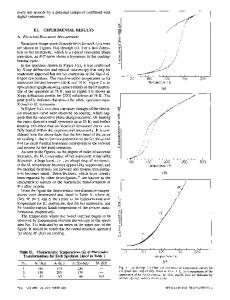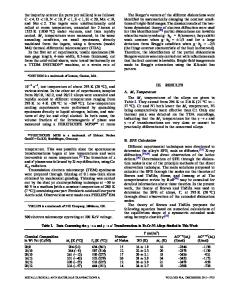Electron microscope study on martensitic transformations in Fe- Pt alloys: General features of internal structure
- PDF / 4,246,205 Bytes
- 9 Pages / 594 x 774 pts Page_size
- 77 Downloads / 447 Views
I.
INTRODUCTION
THEREare a number of reports on martensitic transformation of Fe-Pt alloys near the composition of Fe3Pt because various martensitic transformation characteristics appear in this alloy system. Particularly, an ordered Fe3Pt alloy (LI2 type superlattice) is the only alloy which undergoes an fccbct thermoelastic martensitic transformation among other ferrous alloys, whose fcc-bct (bcc) transformation is nonthermoelastic. Hence, this alloy system has been investigated by some research groups [~-Tj to make clear not only the fcc-bct (bcc) transformation mechanism of ferrous alloys but also the origin of the thermoelastic behavior. One of the conspicuous characteristics of this alloy is that the Ms temperature decreases with increasing degree of order of the austenite, and further, the type of the martensitic transformation changes from nonthermoelastic to thermoelastic. [1~ Associated with this, the martensite formed becomes tetragonal t2'31 and the volume change attending the transformation becomes very small or even negative.I2] Efsic and Waymant41investigated the crystallography of the martensitic transformation in a disordered Fe-24.5 at. pct Pt alloy in detail, and found that martensite plates of the alloy have a habit plane near {3, 15, 10}A and the transformation exhibits a crystallographic relationship which is in good agreement with a prediction of a phenomenological theory. On the other hand, the habit plane normal, directions of the shape strain and relative twin widths of {112} transformation twins calculated by the Wechsler-Lieberman-Read (WLR) theory are not greatly different between the two types of the transformation, but the magnitudes of total shape strain and lattice invariant shear for the thermoelastic type transformation are smaller than those for the other type. tSl Experiments also indicated that the driving force at Ms for disordered alloys was very much larger than that for ordered ones.[~l Transmission electron microscope studies on the martensitic transformation of this alloy system have not been performed so intensively yet. Tadaki and Shimizu t6j found by electron microscopy that the bct martensite has a superlattice which is expected to form from austenite with a L12 type superlattice by the Bain distortion and proved that its S. MUTO, Graduate Student, R. OSHIMA, Associate Professor, and E E. FUJITA, Professor, are with the Department of Material Physics, Faculty of Engineering Science, Osaka University, Toyonaka, Osaka 560, Japan. Manuscript submitted January 7, 1988. METALLURGICALTRANSACTIONSA
transformation twins must be on the {112} planes, not on the {121} or {211} planes, because the twinning shear on the {121} or {211} planes causes twin boundary disordering. This restriction of the twinning deformation modes was considered to ensure the reversibility of the transformation. Kajiwara and Owen t71 observed that the a/~/interface in disordered martensitic specimens contained a high density of loops of sessile dislocations but not the interfaces of ordered specimens
Data Loading...











